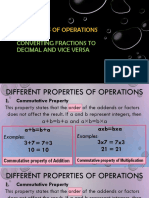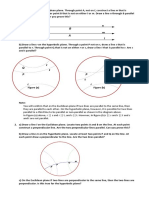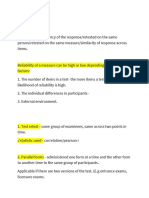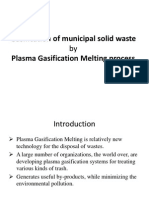0 ratings0% found this document useful (0 votes)
126 viewsHydrology Group 1 MCQ
Hydrology Group 1 MCQ
Uploaded by
Anonymous fuDzSgQHThis document contains questions about meteorology and hydrology concepts. It includes questions about temperature measurement instruments like thermometers; precipitation types like rain, snow, and hail; atmospheric moisture concepts like humidity and dew point; atmospheric circulation drivers; the water cycle; and watershed delineation and hydrologic processes.
Copyright:
© All Rights Reserved
Available Formats
Download as DOCX, PDF, TXT or read online from Scribd
Hydrology Group 1 MCQ
Hydrology Group 1 MCQ
Uploaded by
Anonymous fuDzSgQH0 ratings0% found this document useful (0 votes)
126 views2 pagesThis document contains questions about meteorology and hydrology concepts. It includes questions about temperature measurement instruments like thermometers; precipitation types like rain, snow, and hail; atmospheric moisture concepts like humidity and dew point; atmospheric circulation drivers; the water cycle; and watershed delineation and hydrologic processes.
Original Description:
dandan
Original Title
Hydrology Group 1 Mcq
Copyright
© © All Rights Reserved
Available Formats
DOCX, PDF, TXT or read online from Scribd
Share this document
Did you find this document useful?
Is this content inappropriate?
This document contains questions about meteorology and hydrology concepts. It includes questions about temperature measurement instruments like thermometers; precipitation types like rain, snow, and hail; atmospheric moisture concepts like humidity and dew point; atmospheric circulation drivers; the water cycle; and watershed delineation and hydrologic processes.
Copyright:
© All Rights Reserved
Available Formats
Download as DOCX, PDF, TXT or read online from Scribd
Download as docx, pdf, or txt
0 ratings0% found this document useful (0 votes)
126 views2 pagesHydrology Group 1 MCQ
Hydrology Group 1 MCQ
Uploaded by
Anonymous fuDzSgQHThis document contains questions about meteorology and hydrology concepts. It includes questions about temperature measurement instruments like thermometers; precipitation types like rain, snow, and hail; atmospheric moisture concepts like humidity and dew point; atmospheric circulation drivers; the water cycle; and watershed delineation and hydrologic processes.
Copyright:
© All Rights Reserved
Available Formats
Download as DOCX, PDF, TXT or read online from Scribd
Download as docx, pdf, or txt
You are on page 1of 2
1. It is the numerical measure of hot and cold.
a. Thermometer b. Temperature c. Humidity d. Hydrology
2. The seasonal distribution of precipitation varies widely which shows typical seasonal distributions.
a. Time variation b. Geographic variation c. Record rainfalls d. Geographic distribution
3. It is an instrument that records air temperature continuously on graphing paper.
a. Thermometer b. Thermocouple c. Thermograph d. Pyrometer
4. In the geographic distribution of temperature, surface temperature tends to be highest at _______.
a. High latitudes b. High latitudes c. Low longitudes d. Low latitudes
5. _______ is a change in temperature from day to night brought about by the daily rotation of the earth.
a. Diurnal Variation b. Seasonal Variation c. Variation with latitude d. Variation with topography
6. An instrument used by meteorologists and hydrologists to gather and measure the amount of liquid precipitation over a
set period of time.
a. Rain Gauges b. Tipping Bucket c. Float Type d. Radar Satellite
7.It is a rain gauge which does not provide the distribution of amount of precipitation in a day.
a. Recording rain gauges b. Non-recording rain gauges c. Float type d. Satellite Measurement
8.These rain gauges the catch from the funnel empties into a bucket mounted on a weighing scale.
a. Radar Measurement b. Satellite Measurement c. Weighing Bucket Type d. Float type
9.These rain gauges are also called “Integrating rain gauges” since they record cumulative rainfall.
a. Tipping Bucket b. Float Type c. Rain Gauges d. Recording Rain Gauges
10. The rise of float with increasing catch of rainfall is recorded. Here the rainfall collected by a funnel-shaped collector is
led into a float chamber causing a float to rise.
a. Float Type b. Rain Gauges c. Satellite Measurement d. Weighing Type
11. It refers to the temperature at which one parcel of air would need to be cooled in order to reach saturation, if the air
was cooled further it would condense.
a. water vapor b. absolute humidity c. dew point d. condensation
12. An instrument used for measuring the moisture in the atmosphere.
a. hydrometer b. manometer c. hygrometer d. thermometer
13. It is a measure of the amount of moisture in the air with the amount of moisture the air can hold.
a. relative humidity b. humidity c. dew point d. precipitation
14. It is the source of all condensation and precipitation.
a. dew point b. water vapor c. humidity d. evaporation
15. The total amount of water vapor in a given volume of air and it is the measure of water vapor (moisture) in the air,
regardless of temperature.
a. absolute humidity b. humidity c. Relative humidity d. specific humidity
16. It is a mix of events happen each day in our atmosphere.
a. Atmosphere b. Weather c. Clouds d. Typhoon
17. It is the gaseous envelope surrounding the earth.
a. Atmosphere b. Weather c. Clouds d. Typhoon
18. The weather events happening in an area is controlled by ____.
a. Clouds b. Weather c. Air Pressure d. Atmosphere
19. It is a kind of clouds that you learned to draw in an early stage.
a. Cirrus Clouds b. Cumulus Clouds c. Stratus Clouds d. Nimbostratus Clouds
20. Air pressure is caused by the large number of _____.
a. Wind b. Water c. Gas d. Molecules
21. Forms of precipitation which reaches the ground in liquid form and consist of water drops of diameter between 0.5mm
to 7mm.
a. Rain b. snow c. hail d. sleet
22. Forms of precipitation which is composed of a powdery mass of ice crystals.
a. snow b. rain c. hail d. sleet
23. Forms of precipitation have the potential of causing damage to agricultural crops and other properties.
a. hail b. rain c. snow d. sleet
24. Types of precipitation lifting of unstable air that is warmer than surrounding air due to uneven surface heating.
a. Convective precipitation b. Orographic precipitation c. Frontal precipitation/Cyclonic d. Lame
precipitation
25.Types of precipitation or masses moist air is forced over mountain barriers by westerly air flow & ppt falls on wind.
a. Orographic precipitation b. Convective precipitation c. Frontal precipitation/Cyclonic d. Lame precipitation
26. It is often called the solar resource, is a general term for the electromagnetic radiation emitted by the sun ranging from
about 0.25 to 4.5 μm including the near ultraviolet (UV), visible light, and near infrared (IR) radiation.
a. General Circulation b. Solar Radiation c. Thermal Circulation d. Thermal Energy
27. is that light that the human eye can perceive and uses to view objects.
a. Ultraviolet Radiation b. Infrared Radiation c. Visible light Radiation d. Solar Radiation
28. Air begins to flow as soon as there is a significance difference in air temperature and pressure across the land of sea
gradient. This localized air flow system is called .
a. Sea Breeze b. Mountain Breeze c. Land Breeze d. None of the above
29. What is the exact time does the Earth makes one rotation about its axis?
a. 24 hrs. 2 min b. 23 hrs. 56 mins. 4.0916 secs. c. 23 hrs. 3 secs. d. 18 hrs. 12 mins. 51 secs.
30. It is a circulation generated by pressure gradients produced by differential heating.
a. Thermal Energy b. Thermal Circulation c. General Circulation d. Sun
31. Cycling of water in and out of___________ and between all the earth’s components.
a. Sea b. Atmosphere c. Lake d. River
32. The transformation of water from liquid to gas phases as it moves from the ground or bodies of water into the
overlying atmosphere
a. Transpiration b. Precipitation c. Evaporation d. Condensation
33. The release of water vapor from plants into the atmosphere.
a. Transpiration b. Precipitation c. Evaporation d. Condensation
34. Occurs when a portion of the atmosphere becomes saturated with water vapor.
a. Transpiration b. Precipitation c. Evaporation d. Condensation
35. The infiltration capacity is defined as the maximum rate of infiltration. It is most often measured in______________.
a. meters per hour b. inches per hour c. inches per day d. meters per day
36. It is the area of reception of the rainfalls and of supplying the watercourse; the outlet flows depending thus on its
surface.
a. Watershed b. Groundwater c. Watershed surface d. Headwaters
37. The tool of delineation that allows the user to delineate sub watersheds using a mouse and requires the user’s
knowledge of that watershed’s topography.
a. Manual Delineation b. Automatic Delineation c. Digitalizing Method d. None of the above
38. It represents the contributing area for a particular control point or outlet; used to defined boundaries of the study
areas, and or to divide the study area into sub areas.
a. Watershed divide b. Tributes c. Delineation d. sub-basin
39. A watershed generates a lower outlet flow and presents a higher concentration time.
a. Long shaped b. Fan-shaped c. Delineated d. Undelineated
40. A watershed generates a higher flow and presents a lower concentration time.
a. Long shaped b. Fan- shaped c. Delineated d. Undelineated
41. It is the study of the movement, distribution, and quality of water on Earth and other planets, including the hydrologic
cycle, water resources and environmental watershed sustainability.
a. Hydraulics b. Hydrology c. Fluid Mechanics d. I don’t know, I didn’t listen
42.The Greek word of Hydraulics is ___________.
a. Hydraulikos b. Hydraulos c.Hydraulikas d.Hydraulikous
43. The Melting of ice in ____________ and ____________ causing the sea level to rise rapidly.
a. Greenland and Iceland b. Greenland and Antarctica c. Antarctica and Artic d. Germany and USA
44. ______________ is the conveyance of water or liquids in pipes or other artificial channels.
a. Hydrology b. Hydarulics c.Fluid Mechanics d. Hydraulics
45. Layers of the Atmosphere: _________ is the highest layer. It is where the atmosphere merges into outer space.
a. Troposphere b. Stratosphere c. Exosphere d. Thermosphere
46. It refers to the tendency to promote or inhibit further free rising of air which has been forced to rise initially.
a. Stability of concept b. Stability of the gravity c. Stability of the clouds d. Stability of the atmosphere
47. True or False: If the atmosphere is stable, the air that receives that initial kick to rise will not rise further.
a. True b. False
48. Average depth of storm and its duration for a specific area.
a. Double Mass Analysis b. Depth Area-Duration Analysis
c. Mean Areal Precipitation d. Frequency Analysis
49. Relate the magnitude of extreme events to their frequency of occurrence through the use of probability distributions.
a. Double Mass Analysis b. Depth Area-Duration Analysis
c. Mean Areal Precipitation d. Frequency Analysis
50. Used to determine the consistency of the hydrological data of a particular section.
a. Double Mass Analysis b. Depth Area-Duration Analysis
c. Mean Areal Precipitation d. Frequency Analysis
You might also like
- Generator Hydrogen CoolingDocument31 pagesGenerator Hydrogen CoolingAshwani Dogra80% (5)
- Tutorials QuestionsDocument3 pagesTutorials Questionskarri100% (1)
- BRAC University: Lecture 8: Environmental Resources: Soil and AgricultureDocument26 pagesBRAC University: Lecture 8: Environmental Resources: Soil and AgricultureMu Sh FiqNo ratings yet
- Sedimentary EnvironmentsDocument29 pagesSedimentary Environmentsfahmi fadillaNo ratings yet
- Ch5 Sediments and Sedimentary RocksDocument64 pagesCh5 Sediments and Sedimentary RocksamirNo ratings yet
- E-Classrecord BlankDocument53 pagesE-Classrecord BlankRebbrebb RaveNo ratings yet
- Comparing Means: Samples: T-Tests For One Sample & Two RelatedDocument32 pagesComparing Means: Samples: T-Tests For One Sample & Two RelatedYun YoungNo ratings yet
- Level and Type of InteractivityDocument2 pagesLevel and Type of Interactivitysarah100% (1)
- Properties of Operations: Converting Fractions To Decimal and Vice VersaDocument20 pagesProperties of Operations: Converting Fractions To Decimal and Vice VersaNeleh IlanNo ratings yet
- BSEM Reviewer - GeologyDocument25 pagesBSEM Reviewer - GeologyLoue PayangdoNo ratings yet
- Regional Mass Training of Teachers On Critical Content in Mathematics 8Document52 pagesRegional Mass Training of Teachers On Critical Content in Mathematics 8mikiNo ratings yet
- Types of RocksDocument4 pagesTypes of RocksSajjad AliNo ratings yet
- Effective Teaching of MathDocument32 pagesEffective Teaching of MathOliver IpoNo ratings yet
- Correlation and Regression AnalysisDocument69 pagesCorrelation and Regression Analysisankur basnetNo ratings yet
- Geology Syllabus PDFDocument2 pagesGeology Syllabus PDFChristian GomezNo ratings yet
- Water Pollution An OverviewDocument10 pagesWater Pollution An OverviewShashi Kiran PandeyNo ratings yet
- Part 2 ModuleDocument11 pagesPart 2 ModuleImman Ray Loriezo AguilarNo ratings yet
- 11 - Chemistry & EnvironmentDocument11 pages11 - Chemistry & Environmentsirsa11No ratings yet
- Quanti FiersDocument4 pagesQuanti FiersAngelo LugtuNo ratings yet
- Isomorphism Theorems PDFDocument96 pagesIsomorphism Theorems PDFAyhiel FeedranoNo ratings yet
- Finals in Edu 533Document11 pagesFinals in Edu 533ISSUE TVNo ratings yet
- Lec 3 - Predicates&quantifiers1Document35 pagesLec 3 - Predicates&quantifiers1Julie TrinidadNo ratings yet
- Chapter 09 PDFDocument40 pagesChapter 09 PDFSyed UzairNo ratings yet
- 12 Chemistry Notes Ch03 ElectrochemistryDocument7 pages12 Chemistry Notes Ch03 Electrochemistryhimanshu kumarNo ratings yet
- NFPA DiamondDocument17 pagesNFPA DiamondEurek Mago LumaguiNo ratings yet
- Lapse RateDocument23 pagesLapse RateJamal JalalaniNo ratings yet
- Precipitation. Module 2: Lesson 1. Formation of PrecipitationDocument28 pagesPrecipitation. Module 2: Lesson 1. Formation of PrecipitationDean Albert ArnejoNo ratings yet
- EVS MCQ 25Document4 pagesEVS MCQ 25shanesNo ratings yet
- 2 Stability Assessment of Temporary Rock Cut SlopeDocument61 pages2 Stability Assessment of Temporary Rock Cut SlopeJoseph LuuNo ratings yet
- CE-101 Engineering MechanicsDocument4 pagesCE-101 Engineering MechanicsAbdul Rafey Nawaz100% (1)
- Geology JAM 2016 QPDocument12 pagesGeology JAM 2016 QPH.V. PatilNo ratings yet
- Chapter 4 Surface RunoffDocument38 pagesChapter 4 Surface RunoffMohamad Norazmi Seeni MohamedNo ratings yet
- EutrophicationDocument49 pagesEutrophicationBhe Bhe RanNo ratings yet
- Infiltration: Indices and Measurement of Infiltration (With Diagram)Document9 pagesInfiltration: Indices and Measurement of Infiltration (With Diagram)Ofosu AnimNo ratings yet
- ACTIVITY-3 Principles of GeologyDocument5 pagesACTIVITY-3 Principles of GeologyRogemar PetalloNo ratings yet
- 02 Lecture RunoffDocument16 pages02 Lecture RunoffnorjannahNo ratings yet
- Reviewer Envi-QuizDocument8 pagesReviewer Envi-QuizMariele Tokong Montederamos-Conte0% (1)
- HydrologyDocument4 pagesHydrologyRafia AbidNo ratings yet
- Forces in 3DDocument11 pagesForces in 3DAdeboye BusayoNo ratings yet
- 1 Soil ResourcesDocument24 pages1 Soil ResourcesBelle ÂmeNo ratings yet
- Env PrintDocument29 pagesEnv PrintChethan PintoNo ratings yet
- Chapter 1 Introduction To Hydrology PDFDocument16 pagesChapter 1 Introduction To Hydrology PDFKimmieNo ratings yet
- Environmental Science Set 1Document5 pagesEnvironmental Science Set 1Syed WarnaNo ratings yet
- Air Pollution Meteorology PDFDocument28 pagesAir Pollution Meteorology PDFVinay DograNo ratings yet
- Sedimentary Rocks Are Produced by Surface Processes in The Rock CycleDocument17 pagesSedimentary Rocks Are Produced by Surface Processes in The Rock CycleAdjei BaldanNo ratings yet
- Ch.2.1 Forest Resources (Final)Document61 pagesCh.2.1 Forest Resources (Final)tasleem01No ratings yet
- Mineral Prospecting and ExplorationDocument4 pagesMineral Prospecting and ExplorationnadieNo ratings yet
- Hydrology PPT 02Document18 pagesHydrology PPT 02Got7No ratings yet
- Gaussian PlumesDocument7 pagesGaussian PlumesVeky PamintuNo ratings yet
- Ce 410 - Hydrology Introduction To Hydrology: Impact, Hydrologic Cycle, and PrecipitationDocument29 pagesCe 410 - Hydrology Introduction To Hydrology: Impact, Hydrologic Cycle, and Precipitationsimple-CE-studNo ratings yet
- GroundwaterDocument81 pagesGroundwaterCésar Augusto Niño CastroNo ratings yet
- Aquatic EcosystemDocument10 pagesAquatic EcosystemNooril MoujudhuNo ratings yet
- Matrices: Choose The Most Appropriate Option (A, B, C or D)Document4 pagesMatrices: Choose The Most Appropriate Option (A, B, C or D)JoseNo ratings yet
- Plane and Solid ExamDocument4 pagesPlane and Solid ExamJerome SalvameNo ratings yet
- Chemistry of Atmosphere: Composition of Atmosphere Layers of Atmosphere Cloud Formation Types of CloudsDocument24 pagesChemistry of Atmosphere: Composition of Atmosphere Layers of Atmosphere Cloud Formation Types of CloudsJoshua PerezNo ratings yet
- PorosityDocument13 pagesPorosityRamesh Konakalla0% (1)
- Drought Assessment Using Standard Precipitation IndexDocument6 pagesDrought Assessment Using Standard Precipitation IndexEditor IJTSRDNo ratings yet
- Chapter 2 - Precipitation-Part2Document45 pagesChapter 2 - Precipitation-Part2sheil.cogay100% (1)
- Elements of Environmental Studies: November 2018Document13 pagesElements of Environmental Studies: November 2018Sponge BobNo ratings yet
- Lecture 9 - CE 433Document21 pagesLecture 9 - CE 433SEEMA NIHALANINo ratings yet
- Ecohydrology: Vegetation Function, Water and Resource ManagementFrom EverandEcohydrology: Vegetation Function, Water and Resource ManagementNo ratings yet
- Social Studies Assignment B, C and D Sunday Final DraftDocument8 pagesSocial Studies Assignment B, C and D Sunday Final DraftSharon DeanNo ratings yet
- Standard Practice of Handling, Storage and TRansportation of Chlorine PDFDocument34 pagesStandard Practice of Handling, Storage and TRansportation of Chlorine PDFDan Allister TanNo ratings yet
- Gas Tungsten Arc WeldingDocument2 pagesGas Tungsten Arc WeldingIGNACIO MADRINAN BORRERONo ratings yet
- Gasification of Municipal Solid Waste in The Plasma Gasification Melting ProcessDocument23 pagesGasification of Municipal Solid Waste in The Plasma Gasification Melting ProcessArjuncv100% (3)
- SIMULASI OIL STABILIZATION - Muhammad Rifqi Dwi SeptianDocument11 pagesSIMULASI OIL STABILIZATION - Muhammad Rifqi Dwi SeptianMrds 1997No ratings yet
- 1st Monthly Test in ChemistryDocument3 pages1st Monthly Test in Chemistrycristina brionesNo ratings yet
- Factors Affecting Performance of Vapour Compression System PDFDocument6 pagesFactors Affecting Performance of Vapour Compression System PDFakhudaiwalaNo ratings yet
- Fundamental Properties of Flotation Frothers and Their Effect On FlotationDocument8 pagesFundamental Properties of Flotation Frothers and Their Effect On FlotationJose Luis Barrientos RiosNo ratings yet
- Chapter 1 Introduction PDFDocument9 pagesChapter 1 Introduction PDFLuis BorrazNo ratings yet
- Hydrogen Shobhit NirwanDocument26 pagesHydrogen Shobhit NirwanANMOL SHREYAMNo ratings yet
- Nukiyama & Tanasawa Correlation: Liquid Mean Droplet Size or Sauter Mean DiameterDocument2 pagesNukiyama & Tanasawa Correlation: Liquid Mean Droplet Size or Sauter Mean Diametersreekanth reddyNo ratings yet
- States of MatterDocument5 pagesStates of MatterCartmanTaiNo ratings yet
- Chapter 1:: Petroleum Production SystemDocument20 pagesChapter 1:: Petroleum Production SystemJay JayNo ratings yet
- Basic Principle II Second Class Dr. Arkan Jasim HadiDocument8 pagesBasic Principle II Second Class Dr. Arkan Jasim HadiAman SrivastavaNo ratings yet
- Chapter 3 Problems 7th EditionDocument25 pagesChapter 3 Problems 7th Editionallswell0% (2)
- Grain Boundary - WikipediaDocument8 pagesGrain Boundary - Wikipediaciuciu.denis.2023No ratings yet
- Ref Review ProblemsDocument3 pagesRef Review ProblemsGiancarlo SantosNo ratings yet
- CH8701 Process Equipment Design MCQ 1Document3 pagesCH8701 Process Equipment Design MCQ 1Dhananjay PatilNo ratings yet
- Jai Prakash (Chmeistry)Document14 pagesJai Prakash (Chmeistry)Jai PrakashNo ratings yet
- Chemical Engineering Mass Transfer NotesDocument26 pagesChemical Engineering Mass Transfer NotesLebohang Czar NkuNo ratings yet
- Alarm Trip Setting List 3Document35 pagesAlarm Trip Setting List 3Vraja KisoriNo ratings yet
- UntitledDocument2 pagesUntitledJulie Anne Portal - OdascoNo ratings yet
- Cu-Fe-Ni (Copper-Iron-Nickel) : Binary SystemsDocument4 pagesCu-Fe-Ni (Copper-Iron-Nickel) : Binary Systemsabdul basitNo ratings yet
- The Incredible Journey: ObjectivesDocument5 pagesThe Incredible Journey: ObjectivesnijuyonNo ratings yet
- Analysis of Compressible Flow in FUNDAMENTALS OF FLUID MECHANICSDocument210 pagesAnalysis of Compressible Flow in FUNDAMENTALS OF FLUID MECHANICSAjay kumar100% (1)
- Calculation Dilute Phase Pressure Drop Zenz Othmer MethodDocument8 pagesCalculation Dilute Phase Pressure Drop Zenz Othmer MethodGeorgi Mitkov SavovNo ratings yet
- Chapter 14 The Behavior of GasesDocument59 pagesChapter 14 The Behavior of GasesHeather Wright100% (2)
- Vapour Pressure of Water - Marcet Boiler: Page 1/2 11/2014Document2 pagesVapour Pressure of Water - Marcet Boiler: Page 1/2 11/2014Muhammad UsmanNo ratings yet
- ASTM E406 - 81 (Reapproved 2008)Document4 pagesASTM E406 - 81 (Reapproved 2008)ageofqualityNo ratings yet

























































































